Desiccation Cracking Behavior of Sustainable and Environmentally Friendly Reinforced Cohesive Soils
Abstract
:1. Introduction
1.1. Background
1.2. Soil-strengthening Additives
1.3. Analytical and Numerical Modeling
1.4. Scope of Research
2. Materials and Experimental Methodologies
2.1. Base Soil and Additives
2.2. Desiccation Test
2.3. Digital Image Acquisition and Processing
3. Hydro-Mechanical Model
3.1. Soil Water Flow Equations
3.2. Hydro-Mechanical Coupling
3.3. Mechanical Behavior
3.3.1. Pre-Wall Crack Stress Derivation
3.3.2. Post-Wall Crack Stress Derivation
3.3.3. Stress State Discussion
3.4. Material Properties and Input Parameters
4. Results
4.1. Desiccation Test
4.2. Hydro-Mechanical Model
4.2.1. Hydraulic Model
4.2.2. Mechanical Model Results
4.2.3. Sensitivity Analysis
5. Conclusions
Author Contributions
Funding
Institutional Review Board Statement
Informed Consent Statement
Data Availability Statement
Acknowledgments
Conflicts of Interest
References
- Peron, H.; Hueckel, T.; Laloui, L.; Hu, L.B. Fundamentals of desiccation cracking of fine-grained soils: Experimental characterisation and mechanisms identification. Can. Geotech. J. 2009, 46, 1177–1201. [Google Scholar] [CrossRef]
- Hirobe, S.; Oguni, K. Modeling and numerical investigations for hierarchical pattern formation in desiccation cracking. Phys. D Nonlinear Phenom. 2017, 359, 29–38. [Google Scholar] [CrossRef]
- Rodríguez, R.; Sanchez, M.; Ledesma, A.; Lloret, A. Experimental and numerical analysis of desiccation of a mining waste. Can. Geotech. J. 2007, 44, 644–658. [Google Scholar] [CrossRef]
- Cordero-Arias, J.-A.; Useche, G.; Prat, P.C.; Ledesma, A.; Santamarina, J.C. Soil desiccation cracks as a suction–contraction process. Géotech. Lett. 2017, 7, 279–285. [Google Scholar] [CrossRef]
- Costa, S.; Kodikara, J.; Shannon, B. Salient factors controlling desiccation cracking of clay in laboratory experiments. Géotechnique 2013, 63, 18–29. [Google Scholar] [CrossRef]
- Kodikara, J.K.; Choi, X. A Simplified Analytical Model for Desiccation Cracking of Clay Layers in Laboratory Tests. In Proceedings of the Fourth International Conference on Unsaturated Soils, Carefree, AZ, USA, 2–6 April 2006; pp. 2558–2567. [Google Scholar]
- Jayanthi, P.N.V.; Singh, D.N. Utilization of Sustainable Materials for Soil Stabilization: State-of-the-Art. Adv. Civ. Eng. Mater. 2016, 5, 20150013. [Google Scholar] [CrossRef]
- Shah, V.S. Detection of Microcracks in Concrete Cured at Elevated Temperature. Ph.D. Thesis, University of Florida, Gainesville, FL, USA, 2004. [Google Scholar]
- Consoli, N.C.; Bittar Marin, E.J.; Quiñónez Samaniego, R.A.; Heineck, K.S.; Johann, A.D.R. Use of Sustainable Binders in Soil Stabilization. J. Mater. Civ. Eng. 2019, 31, 06018023. [Google Scholar] [CrossRef]
- Wei, H.; Li, Q.; Han, L.; Wang, F.; Zhang, Y.; Chen, Z. Experimental Research on Deformation Characteristics of Using Silty Clay Modified Oil Shale Ash and Fly Ash as the Subgrade Material after Freeze-Thaw Cycles. Sustainability 2019, 11, 5141. [Google Scholar] [CrossRef] [Green Version]
- Kamon, M.; Nontananandh, S. Combining Industrial Wastes with Lime for Soil Stabilization. J. Geotech. Eng. 1991, 117, 1–17. [Google Scholar] [CrossRef]
- Wild, S.; Kinuthia, J.; Robinson, R.B.; Humphreys, I. Effects of ground granulated blast furnace slag (GGBS) on the strength and swelling properties of lime-stabilized kaolinite in the presence of sulphates. Clay Miner. 1996, 31, 423–433. [Google Scholar] [CrossRef]
- Chaduvula, U.; Viswanadham, B.; Kodikara, J. A study on desiccation cracking behavior of polyester fiber-reinforced expansive clay. Appl. Clay Sci. 2017, 142, 163–172. [Google Scholar] [CrossRef]
- Shokri, N.; Zhou, P.; Keshmiri, A. Patterns of Desiccation Cracks in Saline Bentonite Layers. Transp. Porous Media 2015, 110, 333–344. [Google Scholar] [CrossRef]
- Kalkan, E. Influence of silica fume on the desiccation cracks of compacted clayey soils. Appl. Clay Sci. 2009, 43, 296–302. [Google Scholar] [CrossRef]
- Zumrawi, M.M.E.; Mahjoub, A.M.M.; Alnour, I.M. Effect of Some Chloride Salts on Swelling Properties of Expansive Soil. Univ. Khartoum Eng. J. 2016, 6, 52–58. [Google Scholar]
- Mirzababaei, M.; Miraftab, M.; Mohamed, M.; McMahon, P. Impact of Carpet Waste Fibre Addition on Swelling Properties of Compacted Clays. Geotech. Geol. Eng. 2013, 31, 173–182. [Google Scholar] [CrossRef]
- Ghiassian, H.; Poorebrahim, G.; Gray, D.H. Soil Reinforcement with Recycled Carpet Wastes. Waste Manag. Res. 2004, 22, 108–114. [Google Scholar] [CrossRef]
- Shahnazari, H.; Ghiassian, H.; Noorzad, A.; Shafiee, A.; Tabarsa, A.R.; Jamshidi, R. Shear Modulus of Silty Sand Reinforced by Carpet Waste Strips. J. Seismol. Earthq. Eng. 2009, 11, 133–142. [Google Scholar]
- Chaduvula, U.; Manogaran, I.; Viswanadham, B.V.S.; Kodikara, J. Some Studies on Desiccation Cracking of Fiber-Reinforced Expansive Clay Subjected to Drying and Wetting Cycles. In PanAm Unsaturated Soils 2017; American Society of Civil Engineers: Dallas, TX, USA, 2018; pp. 361–370. [Google Scholar] [CrossRef]
- Izzo, M.Z.; Miletić, M. Sustainable Improvement of the Crack Resistance of Cohesive Soils. Sustainability 2019, 11, 5806. [Google Scholar] [CrossRef] [Green Version]
- Chang, I.; Im, J.; Prasidhi, A.K.; Cho, G.-C. Effects of Xanthan gum biopolymer on soil strengthening. Constr. Build. Mater. 2015, 74, 65–72. [Google Scholar] [CrossRef]
- Soldo, A.; Miletić, M. Study on Shear Strength of Xanthan Gum-Amended Soil. Sustainability 2019, 11, 6142. [Google Scholar] [CrossRef] [Green Version]
- Soldo, A.; Miletić, M.; Auad, M.L. Biopolymers as a sustainable solution for the enhancement of soil mechanical properties. Sci. Rep. 2020, 10, 267. [Google Scholar] [CrossRef] [PubMed] [Green Version]
- Chen, R.; Zhang, L.; Budhu, M. Biopolymer Stabilization of Mine Tailings. J. Geotech. Geoenviron. Eng. 2013, 139, 130128212232006. [Google Scholar] [CrossRef]
- Das, S.K.; Mahamaya, M.; Panda, I.; Swain, K. Stabilization of Pond Ash using Biopolymer. Procedia Earth Planet. Sci. 2015, 11, 254–259. [Google Scholar] [CrossRef] [Green Version]
- Al-Alaily, H.S.; Hassan, A.A.A.; Hussein, A.A. Use of extended finite element method and statistical analysis for modelling the corrosion-induced cracking in reinforced concrete containing metakaolin. Can. J. Civ. Eng. 2018, 45, 167–178. [Google Scholar] [CrossRef]
- Ling, J.; Tao, Z.; Qian, J.; Fu, W. Investigation the influences of geotextile on reducing the thermal reflective cracking using XFEM. Int. J. Pavement Eng. 2018, 19, 391–398. [Google Scholar] [CrossRef]
- Liu, P. Extended finite element method for strong discontinuity analysis of strain localization of non-associative plasticity materials. Int. J. Solids Struct. 2015, 72, 174–189. [Google Scholar] [CrossRef]
- Sánchez, M.; Manzoli, O.L.; Guimarães, L.J. Modeling 3-D desiccation soil crack networks using a mesh fragmentation technique. Comput. Geotech. 2014, 62, 27–39. [Google Scholar] [CrossRef]
- Remmers, J.J.; De Borst, R.R.; Needleman, A. The simulation of dynamic crack propagation using the cohesive segments method. J. Mech. Phys. Solids 2008, 56, 70–92. [Google Scholar] [CrossRef]
- Amarasiri, A.L.; Kodikara, J.K.; Costa, S. Numerical modelling of desiccation cracking. Int. J. Numer. Anal. Methods Géoméch. 2011, 35, 82–96. [Google Scholar] [CrossRef]
- Sima, J.; Jiang, M.; Zhou, C. Numerical simulation of desiccation cracking in a thin clay layer using 3D discrete element modeling. Comput. Geotech. 2014, 56, 168–180. [Google Scholar] [CrossRef]
- Guo, Y.; Han, C.; Yu, X. Laboratory characterization and discrete element modeling of shrinkage and cracking in clay layer. Can. Geotech. J. 2018, 55, 680–688. [Google Scholar] [CrossRef] [Green Version]
- El Youssoufi, M.S.; Delenne, J.-Y.; Radjai, F. Self-stresses and crack formation by particle swelling in cohesive granular media. Phys. Rev. E 2005, 71, 051307. [Google Scholar] [CrossRef] [Green Version]
- Gui, Y.; Zhao, G. Modelling of laboratory soil desiccation cracking using DLSM with a two-phase bond model. Comput. Geotech. 2015, 69, 578–587. [Google Scholar] [CrossRef]
- Gui, Y.; Zhao, Z.; Kodikara, J.; Bui, H.H.; Yang, S.-Q. Numerical modelling of laboratory soil desiccation cracking using UDEC with a mix-mode cohesive fracture model. Eng. Geol. 2016, 202, 14–23. [Google Scholar] [CrossRef]
- Abu-Hejleh, A.N.; Znidarčić, D. Desiccation Theory for Soft Cohesive Soils. J. Geotech. Eng. 1995, 121, 493–502. [Google Scholar] [CrossRef]
- Konrad, J.-M.; Ayad, R. A idealized framework for the analysis of cohesive soils undergoing desiccation. Can. Geotech. J. 1997, 34, 477–488. [Google Scholar] [CrossRef]
- D18 Committee. Test Methods for Liquid Limit, Plastic Limit, and Plasticity Index of Soils; ASTM international: West Conshohocken, PA, USA, 2018. [Google Scholar] [CrossRef]
- KAOLIN|CAMEO Chemicals|NOAA. Available online: https://cameochemicals.noaa.gov/chemical/25036 (accessed on 9 April 2020).
- GOM Correlate|GOM. Available online: https://www.gom.com/3d-software/gom-correlate.html (accessed on 12 March 2020).
- Tripathy, S.; Tadza, M.Y.M.; Thomas, H.R. Soil-water characteristic curves of clays. Can. Geotech. J. 2014, 51, 869–883. [Google Scholar] [CrossRef] [Green Version]
- Baille, W.; Tripathy, S.; Schanz, T. Effective Stress in Clays of Various Mineralogy. Vadose Zone J. 2014, 13. [Google Scholar] [CrossRef]
- Richards, L.A. Capillary conduction of liquids through porous mediums. Physics 1931, 1, 318–333. [Google Scholar] [CrossRef]
- van Genuchten, M.T. A Closed-form Equation for Predicting the Hydraulic Conductivity of Unsaturated Soils. Soil Sci. Soc. Am. J. 1980, 44, 892–898. [Google Scholar] [CrossRef] [Green Version]
- Hills, R.G.; Porro, I.; Hudson, D.B.; Wierenga, P.J. Modeling one-dimensional infiltration into very dry soils: 1. Model development and evaluation. Water Resour. Res. 1989, 25, 1259–1269. [Google Scholar] [CrossRef]
- TIMOSHENKO. Theory of Elasticity; Mcgraw Hill Education: New York, NY, USA, 2010. [Google Scholar]
- Wu, J.-H.; Yuan, J.-P.; Ng, C.W.W. Theoretical and experimental study of initial cracking mechanism of an expansive soil due to moisture-change. J. Cent. South Univ. 2012, 19, 1437–1446. [Google Scholar] [CrossRef]
- Tang, C.-S.; Cui, Y.-J.; Shi, B.; Tang, A.-M.; Liu, C. Desiccation and cracking behaviour of clay layer from slurry state under wetting–drying cycles. Geoderma 2011, 166, 111–118. [Google Scholar] [CrossRef] [Green Version]
- Stirling, R. Multiphase Modelling of Desiccation Cracking in Compacted Soils. Ph.D. Thesis, Newcastle University, Newcastle upon Tyne, UK, May 2014. [Google Scholar]
- Fatahi, B.; Khabbaz, H.; Fatahi, B. Mechanical characteristics of soft clay treated with fibre and cement. Geosynth. Int. 2012, 19, 252–262. [Google Scholar] [CrossRef] [Green Version]
- Jiang, P.; Mao, T.; Li, N.; Jia, L.; Zhang, F.; Wang, W. Characterization of Short-Term Strength Properties of Fiber/Cement-Modified Slurry. Adv. Civ. Eng. 2019, 2019, 3789403. [Google Scholar] [CrossRef] [Green Version]
- Chen, C.; Wu, L.; Perdjon, M.; Huang, X.; Peng, Y. The drying effect on xanthan gum biopolymer treated sandy soil shear strength. Constr. Build. Mater. 2019, 197, 271–279. [Google Scholar] [CrossRef] [Green Version]
- Adhesion Coefficient|NAVFAC DM 7.2|GEO5|Online Help. Available online: https://www.finesoftware.eu/help/geo5/en/adhesion-coefficient-01/ (accessed on 5 March 2020).
- Izzo, M. Desiccation Cracking Behavior of Sustainable and Environmentally Friendly Reinforced Cohesive Soils. April 2020. Available online: https://etd.auburn.edu/handle/10415/7129 (accessed on 26 April 2020).
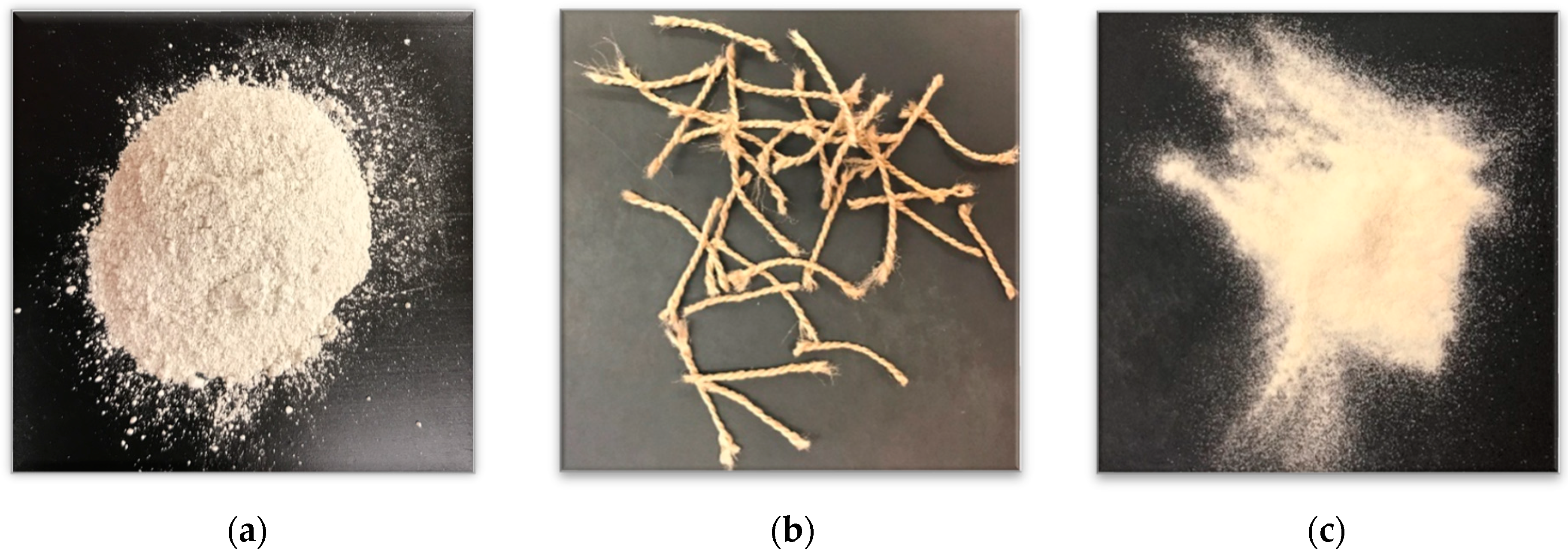
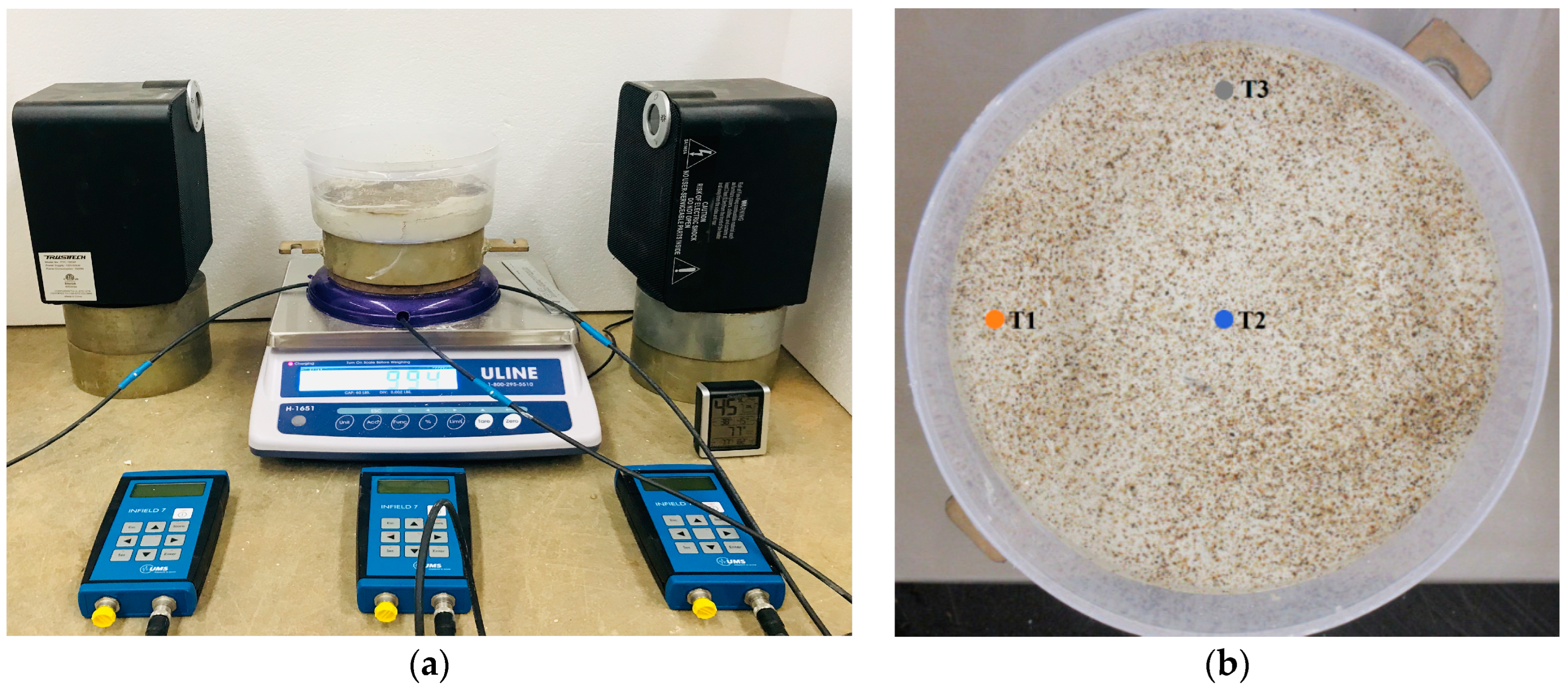

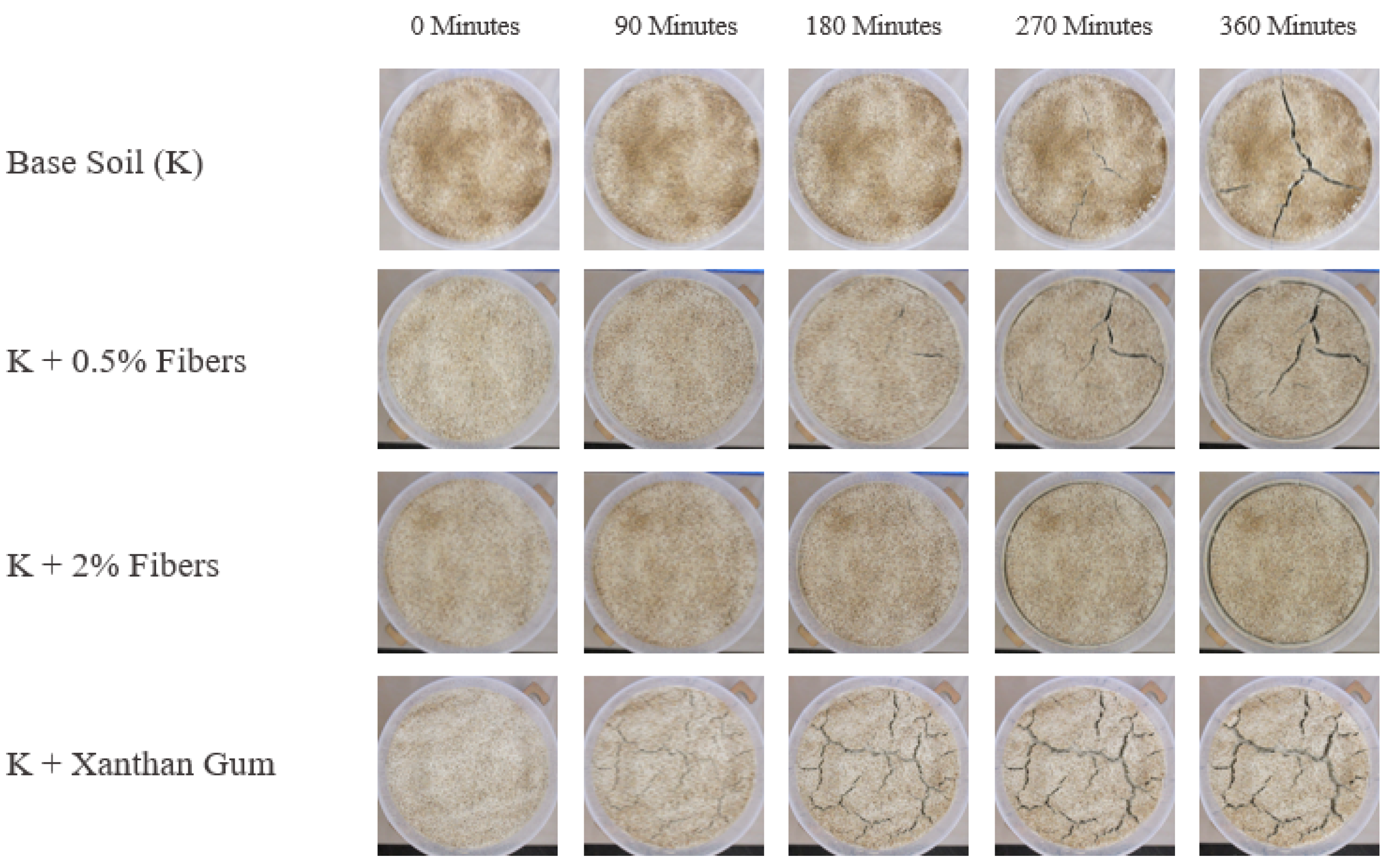

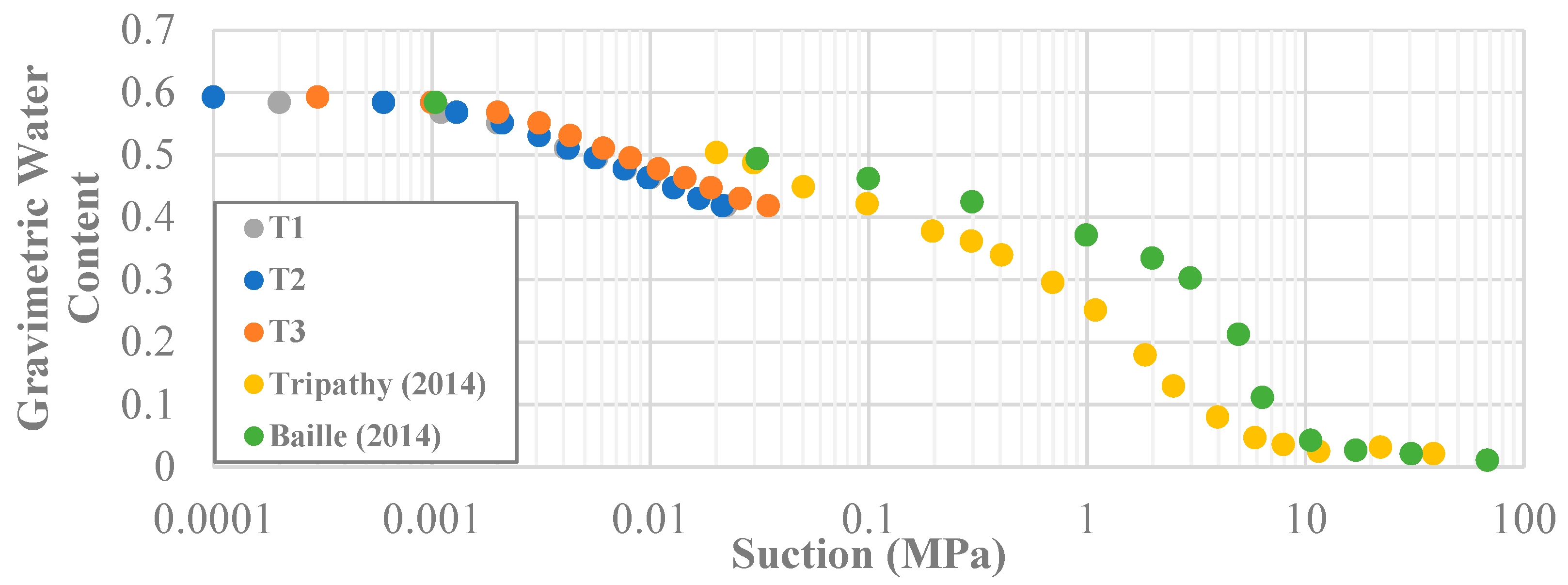
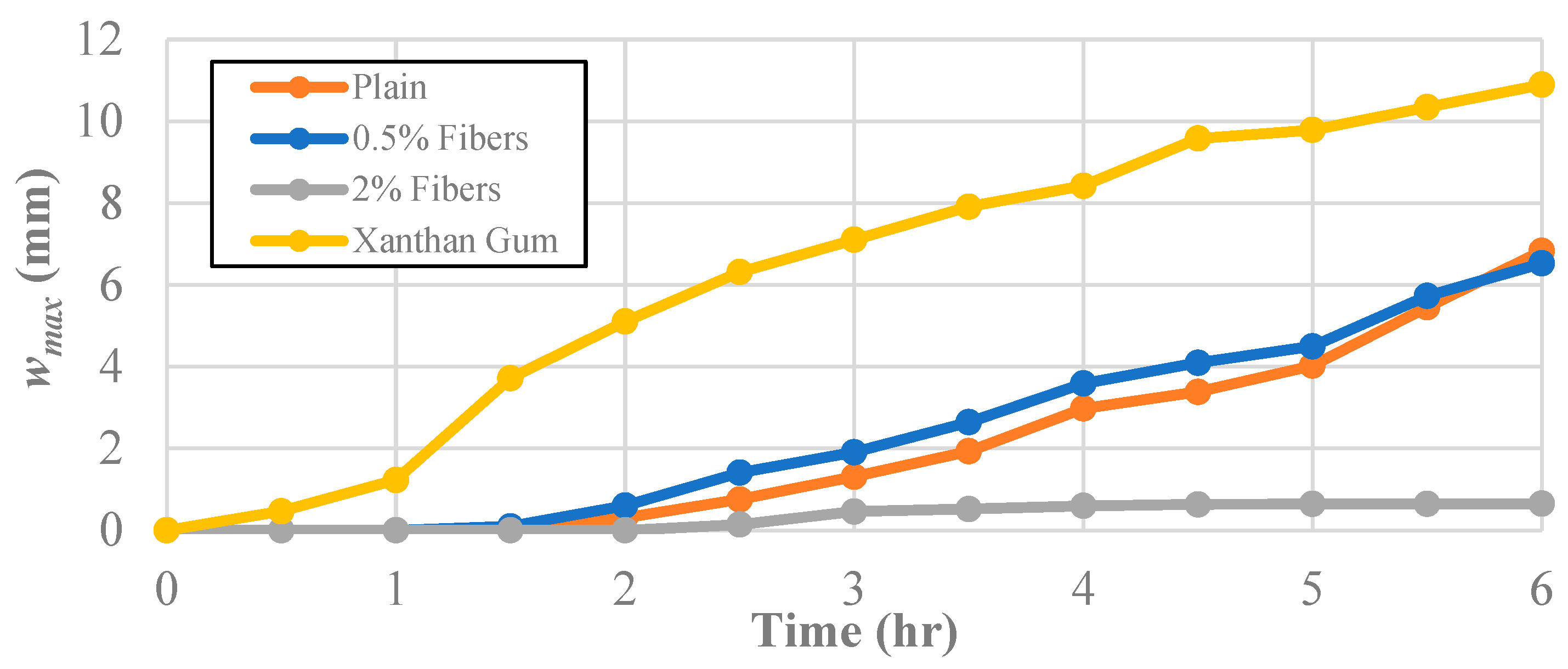


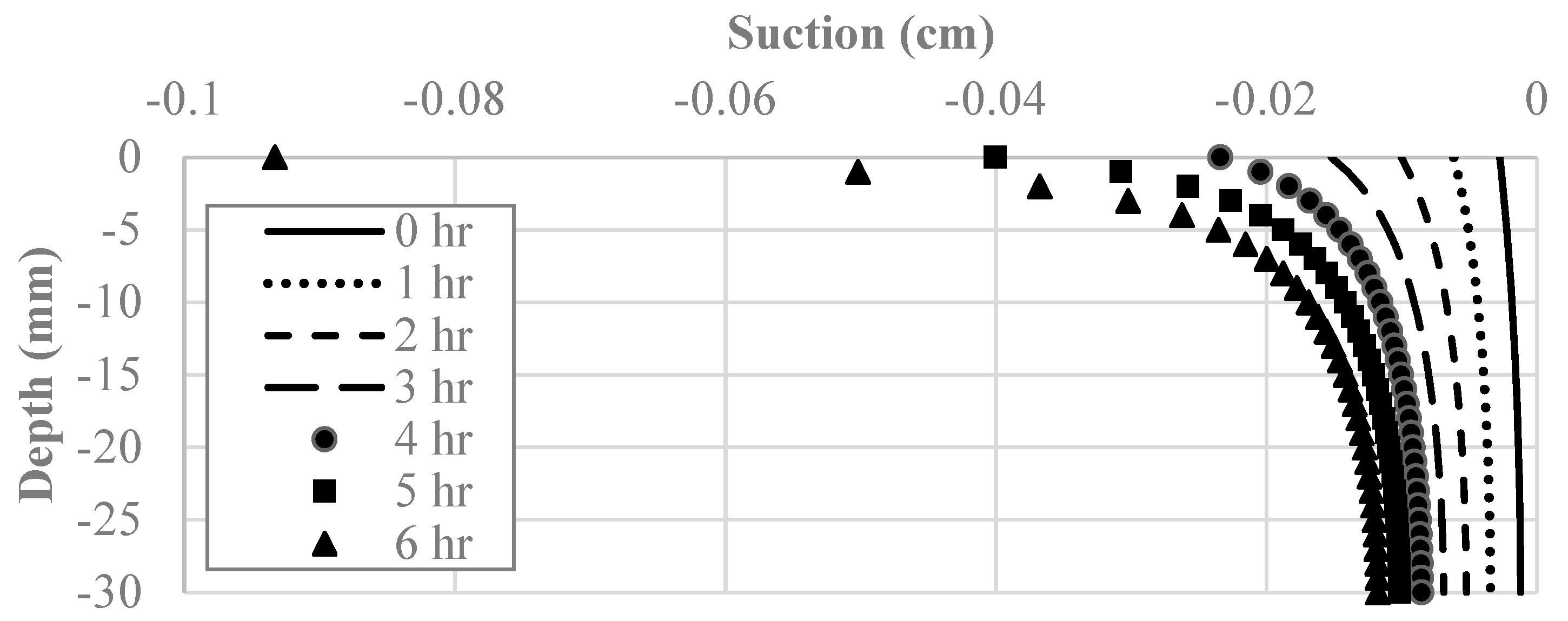
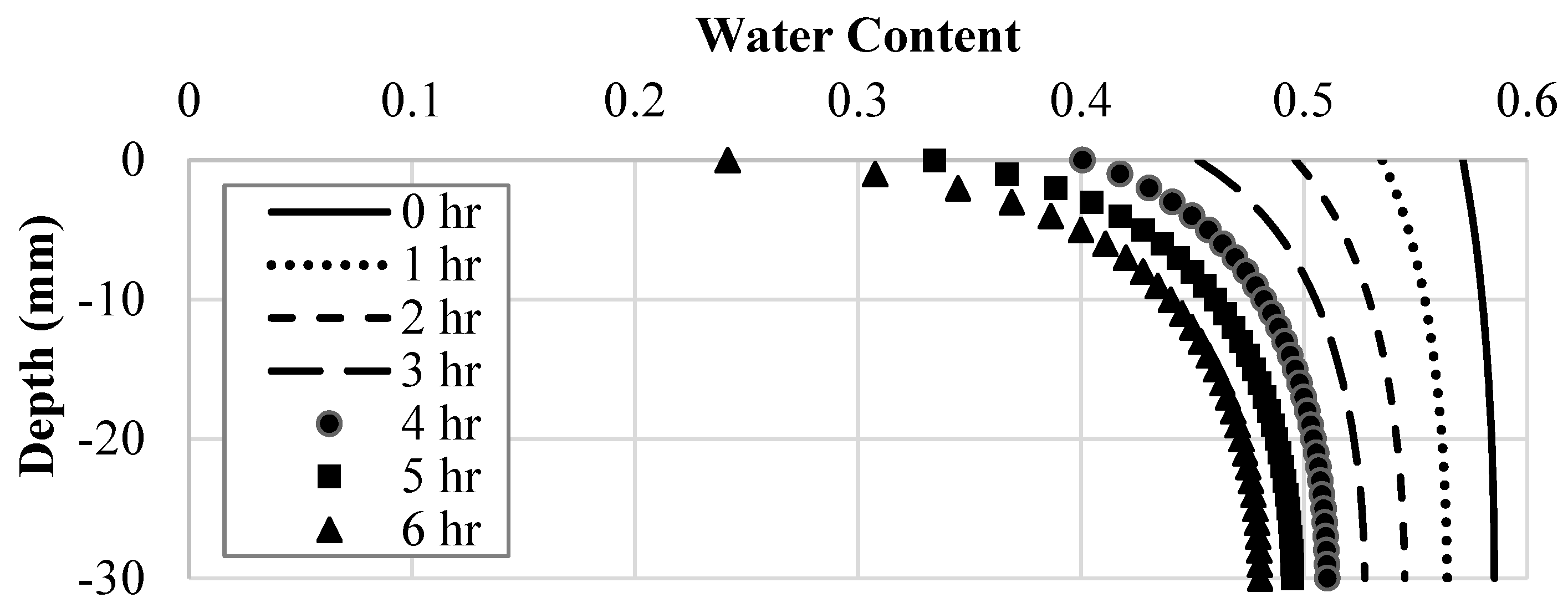
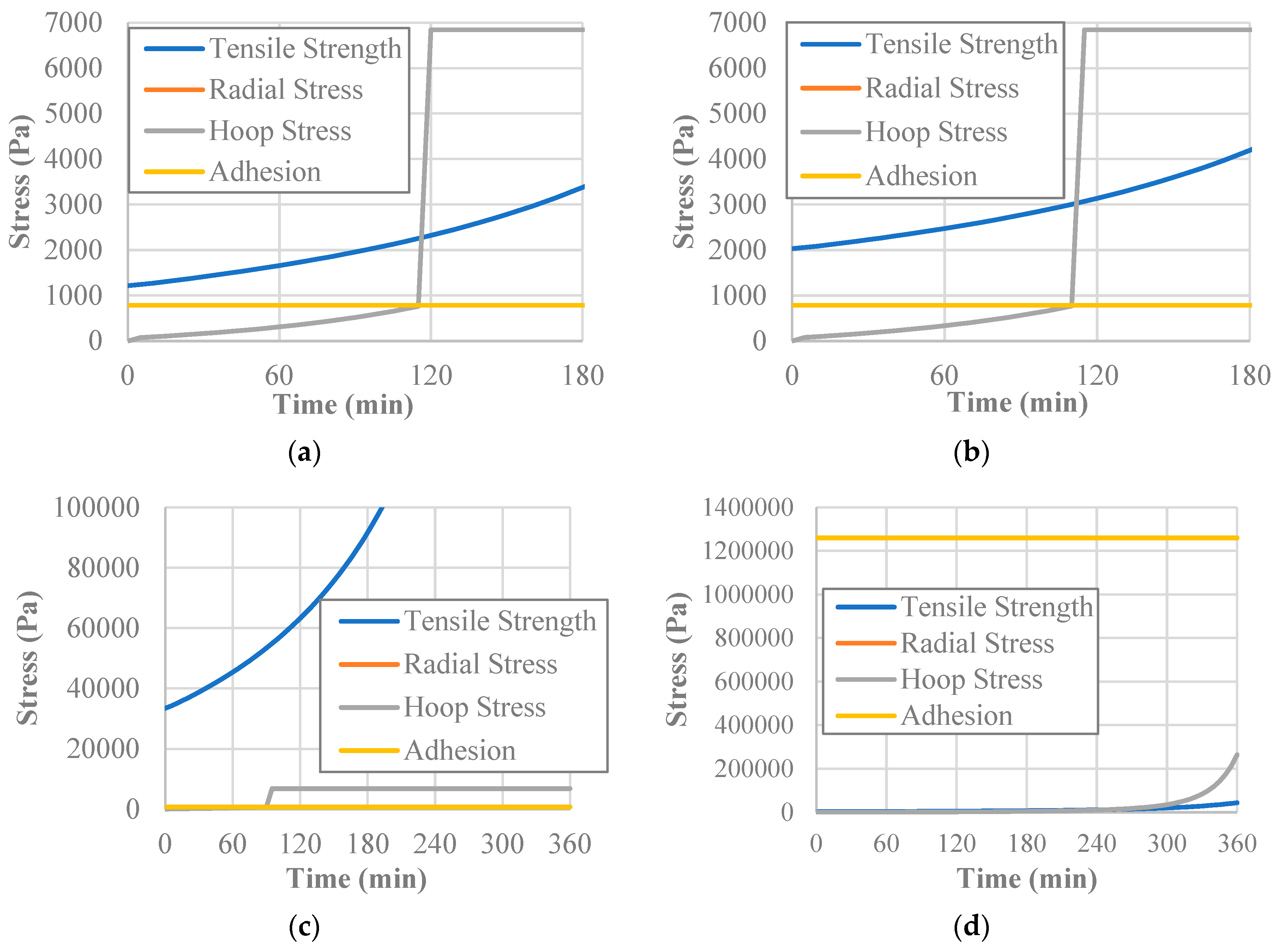
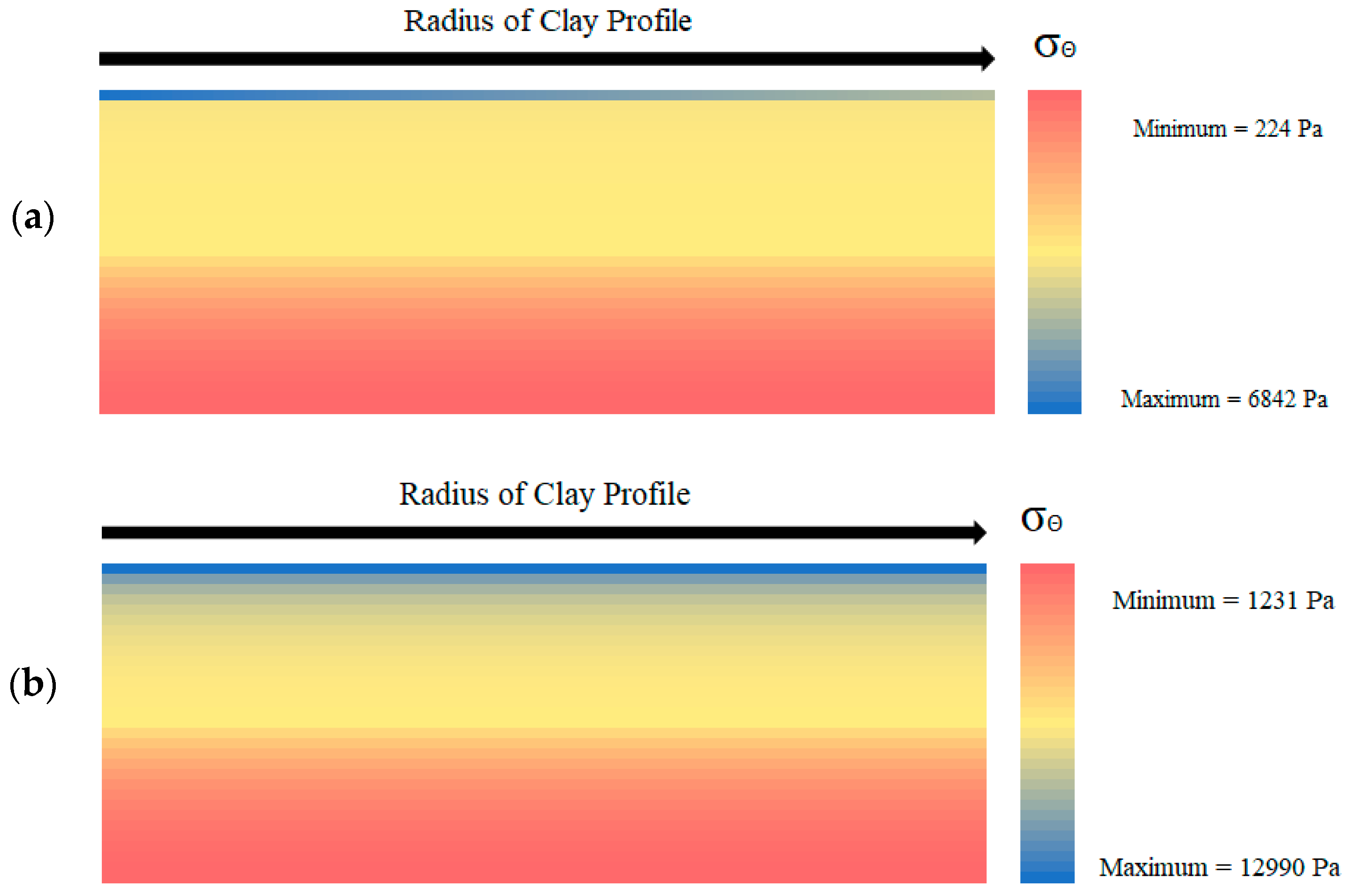
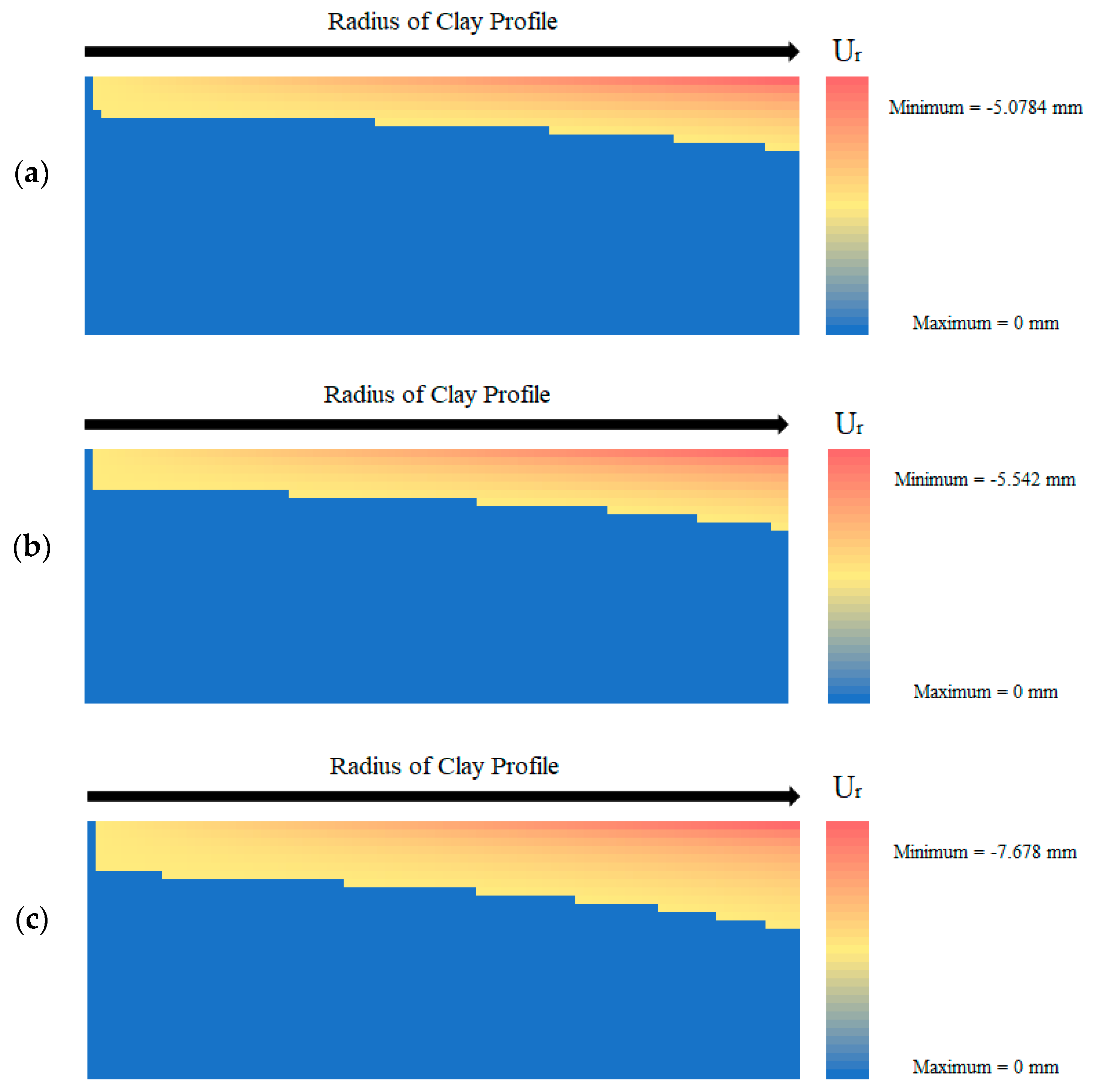


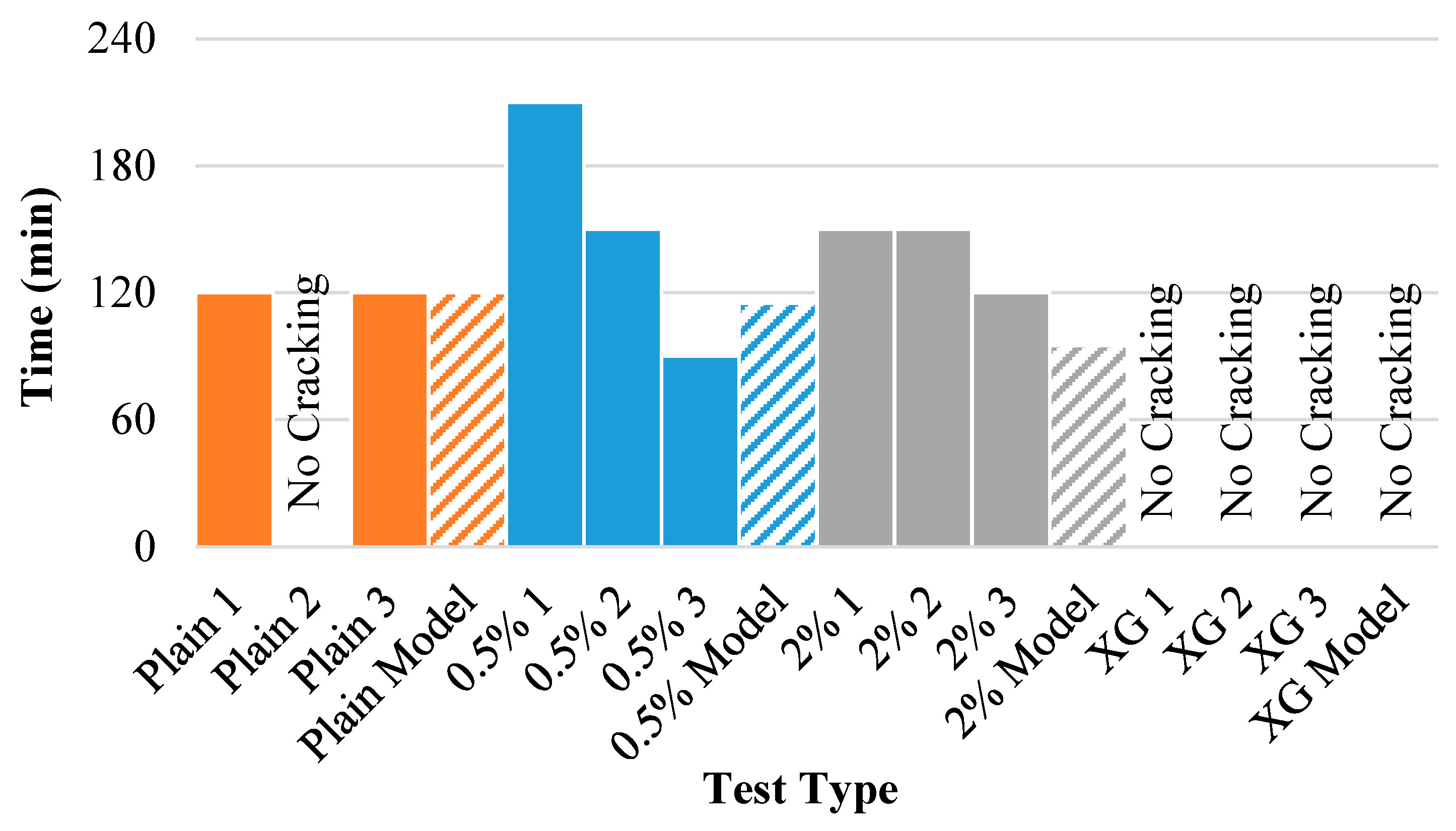
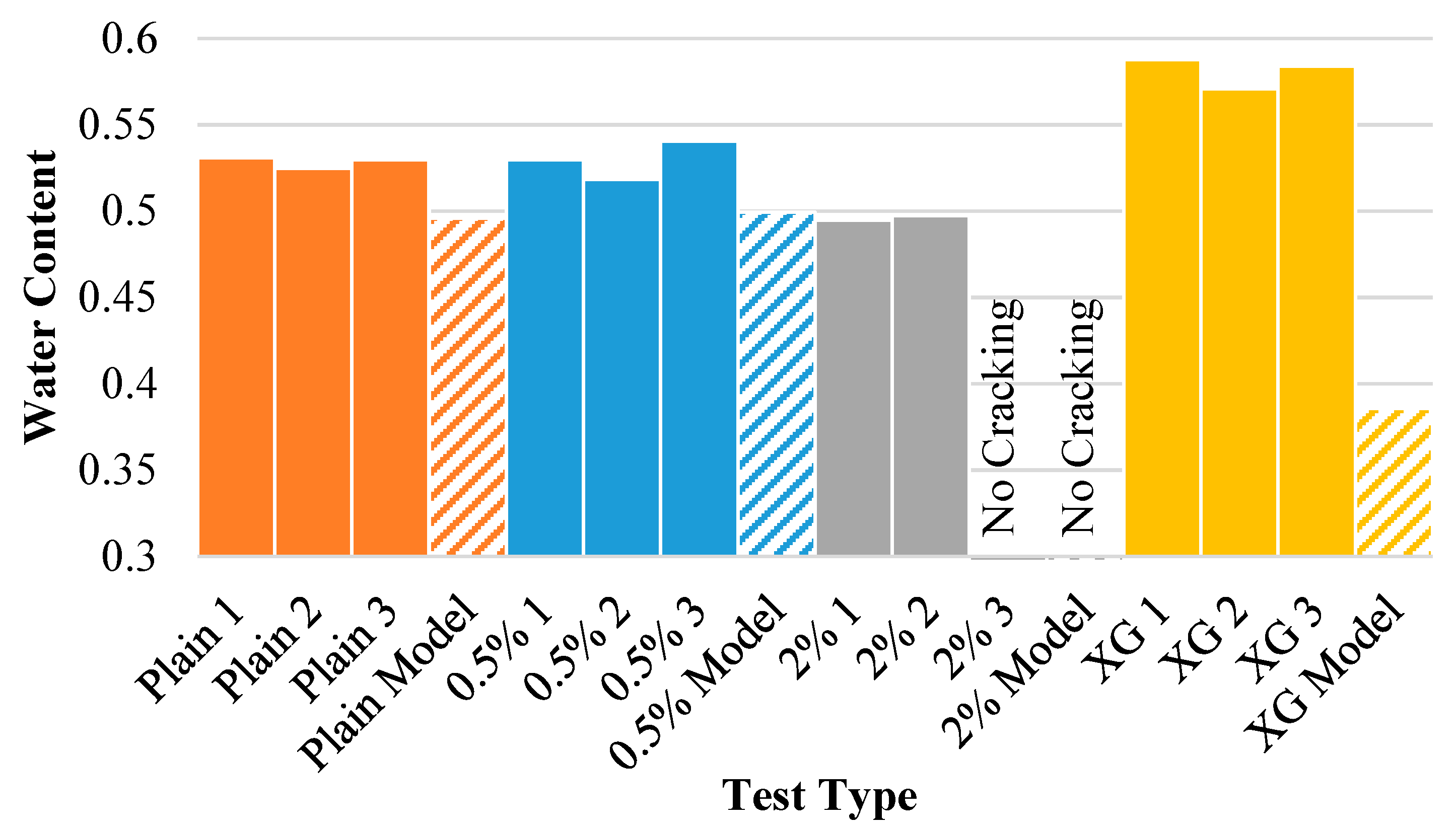
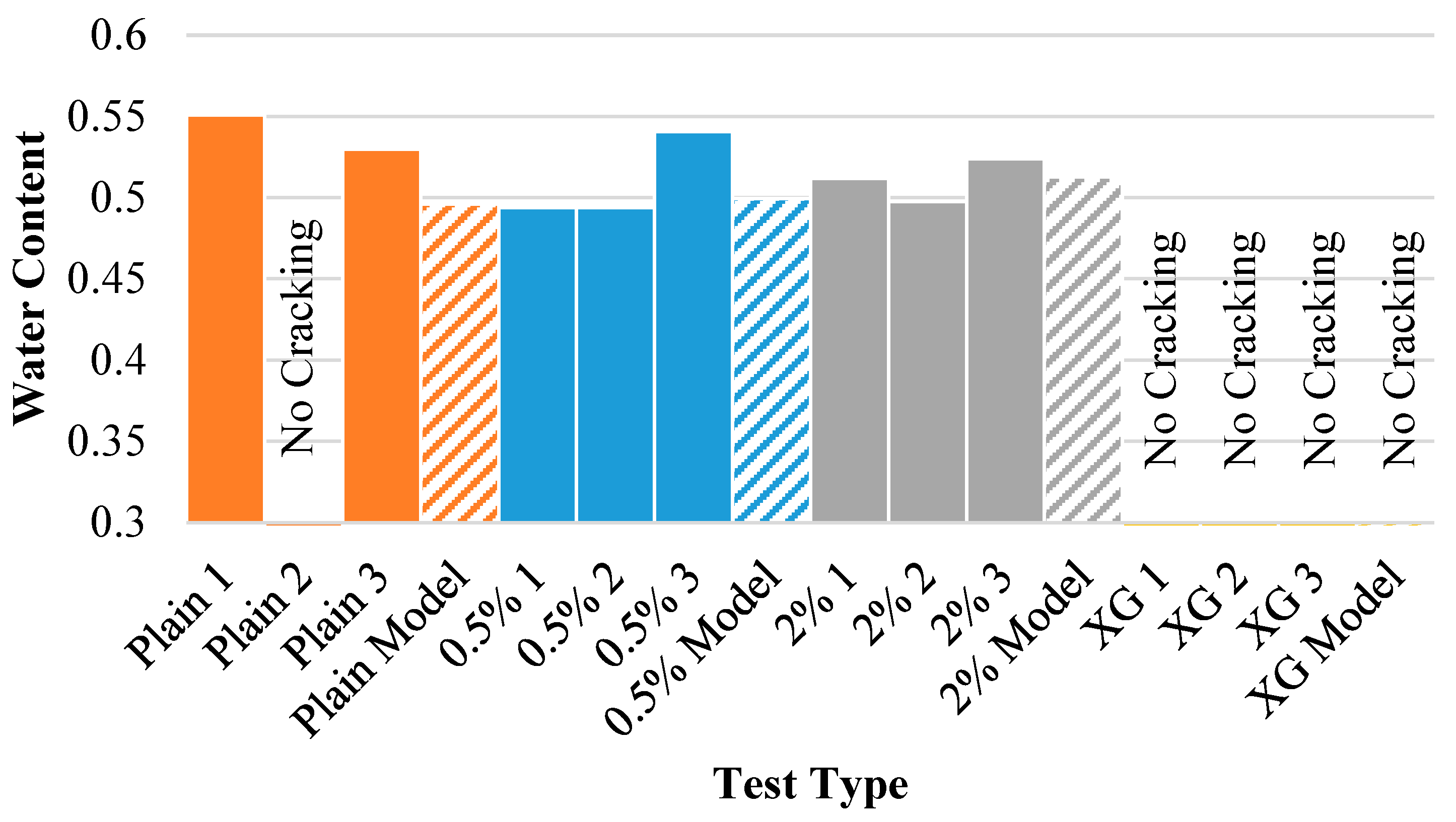

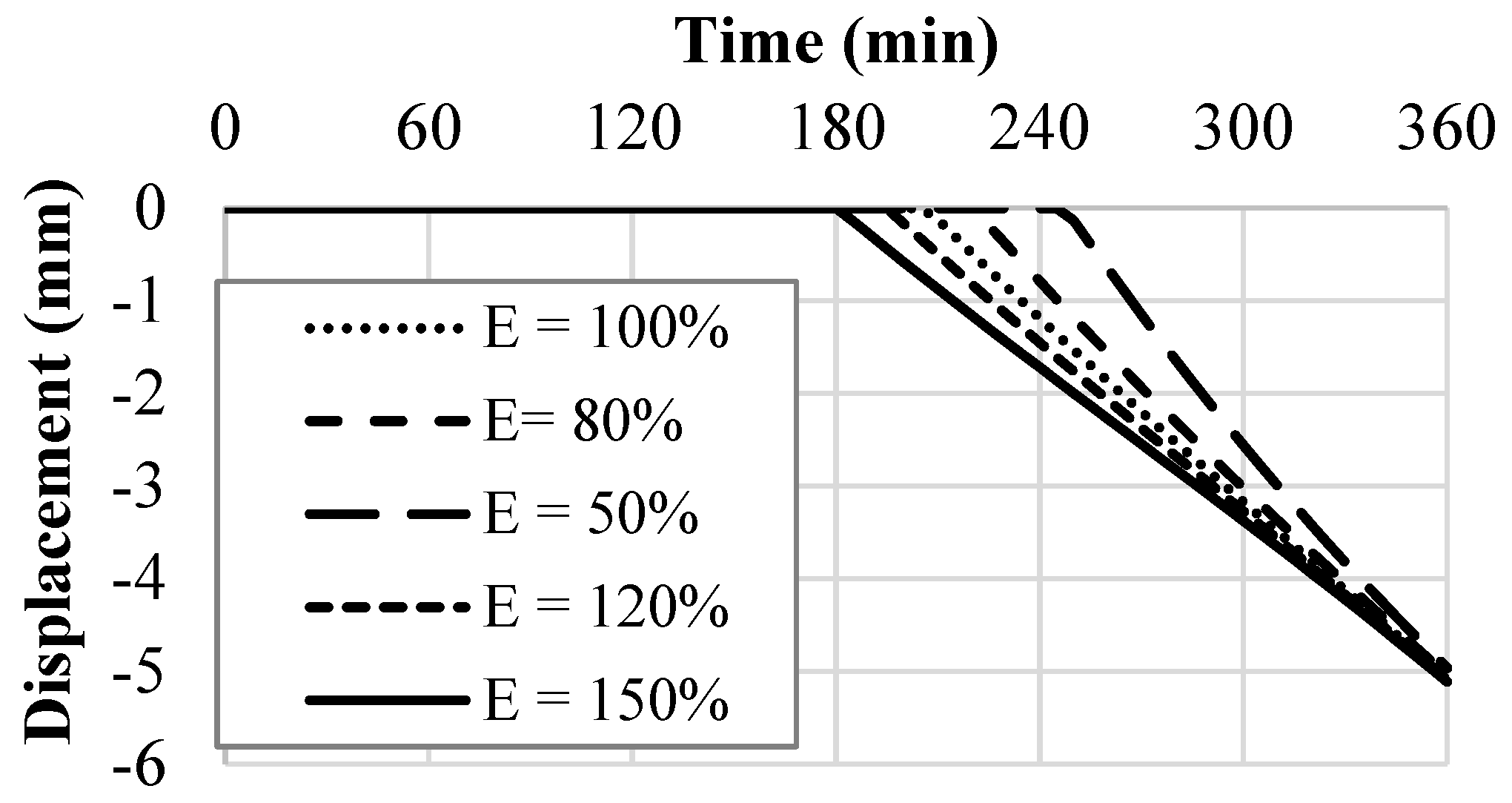

Publisher’s Note: MDPI stays neutral with regard to jurisdictional claims in published maps and institutional affiliations. |
© 2022 by the authors. Licensee MDPI, Basel, Switzerland. This article is an open access article distributed under the terms and conditions of the Creative Commons Attribution (CC BY) license (https://creativecommons.org/licenses/by/4.0/).
Share and Cite
Izzo, M.Z.; Miletić, M. Desiccation Cracking Behavior of Sustainable and Environmentally Friendly Reinforced Cohesive Soils. Polymers 2022, 14, 1318. https://doi.org/10.3390/polym14071318
Izzo MZ, Miletić M. Desiccation Cracking Behavior of Sustainable and Environmentally Friendly Reinforced Cohesive Soils. Polymers. 2022; 14(7):1318. https://doi.org/10.3390/polym14071318
Chicago/Turabian StyleIzzo, Michael Z., and Marta Miletić. 2022. "Desiccation Cracking Behavior of Sustainable and Environmentally Friendly Reinforced Cohesive Soils" Polymers 14, no. 7: 1318. https://doi.org/10.3390/polym14071318
APA StyleIzzo, M. Z., & Miletić, M. (2022). Desiccation Cracking Behavior of Sustainable and Environmentally Friendly Reinforced Cohesive Soils. Polymers, 14(7), 1318. https://doi.org/10.3390/polym14071318





